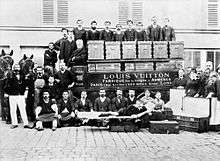Louis Vuitton (designer)
| Louis Vuitton | |
|---|---|
 Louis Vuitton, founder of the House of Louis Vuitton | |
| Born |
4 August 1821 Anchay, Jura, France |
| Died |
27 February 1892 (aged 70) Asnières-sur-Seine, France |
| Occupation | Malletier |
| Known for | The founder of Louis Vuitton |
| Spouse(s) | Clemence-Emilie Parriaux |
| Parent(s) |
Xavier Vuitton Corinne Gaillard |
Louis Vuitton (4 August 1821 – 27 February 1892)[1] was a French fashion designer and businessman. He was the founder of the Louis Vuitton brand of leather goods now owned by LVMH. Prior to this, he had been appointed as trunk-maker to Empress Eugénie de Montijo, wife of Napoleon III.[2]
Early life
Vuitton was born on 4 August 1821 in Anchay in the Jura region in Eastern France. Descended from a long-established working-class French family, Vuitton's ancestors were joiners, carpenters, farmers and milliners. His father, Xavier Vuitton, was a farmer, and his mother, Corinne Gaillard, was a milliner. Vuitton's mother died when he was only 10 years old, and his father soon followed.
Work and career

On the first day of tolerable weather in the spring of 1835, at the age of 13, Vuitton left home alone and on foot, bound for Paris. He traveled for more than two years, taking odd jobs to feed himself along the way and staying wherever he could find shelter, as he walked the 292-mile trek from his native Anchay to Paris. He arrived in 1837, at the age of 16.
While there was widespread poverty in Paris the city was also being transformed by the Industrial revolution. Vuitton was taken on as an apprentice in the workshop of a successful box-maker and packer named Monsieur Marechal. In 19th-century Europe, box-making and packing was a highly respectable and urbane craft. A box-maker and packer custom-made all boxes to fit the goods they stored and personally loaded and unloaded the boxes. It took Vuitton only a few years to stake out a reputation amongst Paris's fashionable class as one of the city's premier practitioners of his new craft.
In 1854, at age 33, Vuitton married 17-year-old Clemence-Emilie Parriaux. Soon after the marriage, he left Marechal's shop, and opened his own box-making and packing workshop in Paris. Outside the shop a sign hung reading "Securely packs the most fragile objects. Specializing in packing fashions."[3] Four years later in 1858, Vuitton introduced his revolutionary stackable rectangular shaped trunks to a market that only had rounded tops. This demand spurred his expansion into a larger workshop outside of Paris.
After the re-establishment of the French Empire under Napoleon III, Vuitton was hired as personal box maker and packer to the Empress of France, Spanish countess Eugenie de Montijo. She charged him with "packing the most beautiful clothes in an exquisite way." De Montijo provided Vuitton with a gateway other elite and royal clients who provided him with work for the rest of his career.
Death
He continued to work until his death at the age of 70 on 27 February 1892. After his death, his son Georges Vuitton took over control of the company.[3]
References
- ↑ "Timeline". Louis Vuitton. Retrieved 3 March 2008.
- ↑ Martin, Richard (1995). Contemporary fashion. London: St. James Press. p. 750. ISBN 1-55862-173-3.
- 1 2 "Louis Vuitton". Vogue UK.